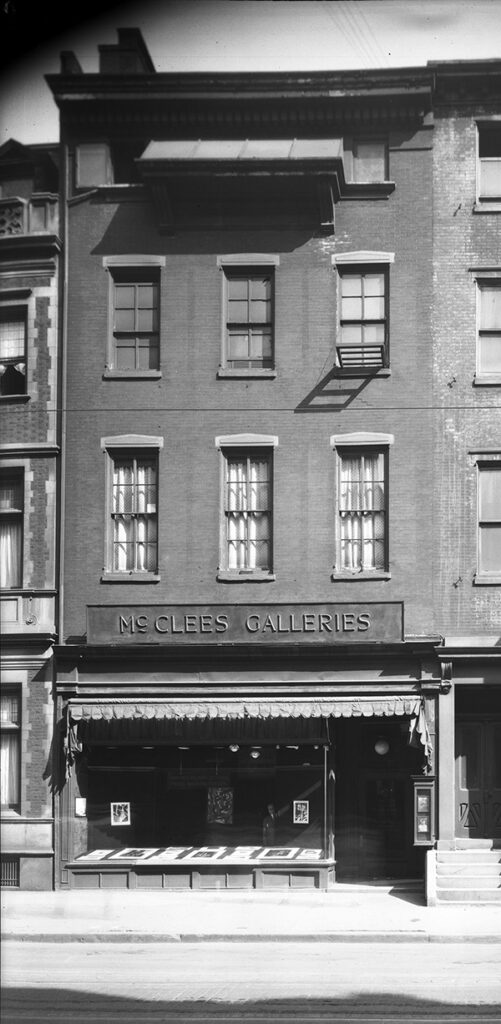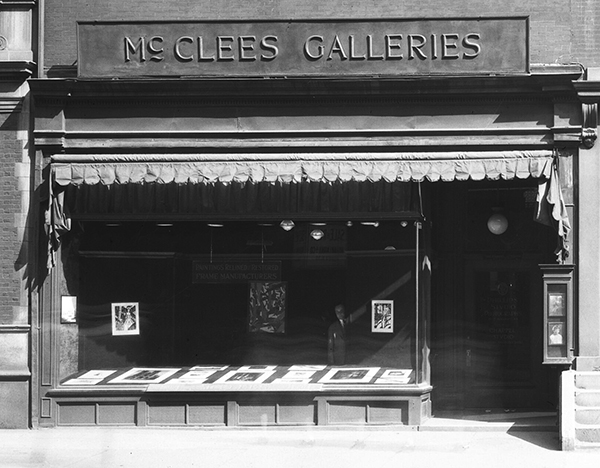Morton Livingston Schamberg believed in the power of art, specifically modern art. As a Philadelphia-born and trained artist who studied at the Pennsylvania Academy of the Fine Arts then Paris, Schamberg put his work, and his faith, in New York’s Armory Show in 1913. He also stepped up as both practitioner and advocate for all things modern in his hometown, where Schamberg was way ahead of his time.
In a pre-Armory Show essay published in the Philadelphia Inquirer, Schamberg provided what art historian Wilford Scott called an “eloquent defense of modern art.” Joseph Rishel, of the Philadelphia Museum of Art, much later praised the essay as “lucid” but also “prudent, given the anticipation of hostility from his audience.”
Schamberg attempted “to place modern painting in some historical perspective,” stating that “the art of Cezanne, Matisse, of Picasso, etc. is based upon the same ideas as that of Italy, Greece, Egypt, India, China, Africa or Mexico, in fact, of the art of all the centuries since its first manifestations.”

But much of the Philadelphia art establishment didn’t buy Schamberg’s argument. Helen Henderson, the Inquirer’s art critic, admitted that modern works seemed “replete with a thousand intoxicating possibilities” and might ultimately “rouse us from indifference.” But not quite yet. Most still considered work of the Post Impressionists as “weird shrieks” leaving art lovers with “nothing…of what they knew and loved but the frames.”
Schamberg had his work cut out for him.
Three years later, with fellow artist Lyman Saÿen, Schamberg seized the opportunity to assemble and present “a small but brilliantly chosen” and, according to Rishel, “boldly” titled “miniature version of the Armory Show.”
Finally Philadelphians might just be willing to dip their collective toe in the new and exciting.

“Philadelphia’s First Exhibition of Advanced Modern Art” opened at the McClees Gallery, 1507 Walnut Street on May 17th, 1916. According to Sylvia Yount, formerly of the Pennsylvania Academy of the Fine Arts and more recently the Metropolitan Museum of Art, this was “the first major presentation of avant-garde art in Philadelphia.”
Henderson noted the success of Schamberg’s “little exhibition of modern art.” It “created no little interest in the city, proving how ready is the public to visit art exhibitions of a live and interesting character. The exhibition proved the most popular one ever held in this gallery, and attracted an unprecedented number of visitors.”
In addition to selecting, arranging and hanging the show, Schamberg embedded himself in the gallery as an on-site interpreter, engaging visitors interested in understanding modern art, much as Alfred Stieglitz did at 291, his gallery in New York. And more: Schamberg wrote a preface to the show praised by Henderson as “excellent and illuminating.” This would “very much assist the spectator to whom the pictures appear enigmatic.”
According to Scott, the selection was “intended to reveal how the modern artist had discarded the mere ‘story-telling’ elements of traditional art, in order to concentrate on the embodiment of ‘pure esthetic emotion’ of abstract compositions.” But words could only do so much. To achieve a complete understanding of this new “psychology of aesthetics” and to thoroughly grasp how non-representational art could lead to “purely visual pleasure,” that would require both “time and familiarity.” Schamberg concluded his preface with this advice: “The best answer could be found in the pictures themselves.”
And what, exactly, was hung in this watershed exhibition? Works by artists both foreign and American, including several on the threshold of iconic fame: Constantin Brâncuși, Georges Braque, Jean Crotti, Andre Derain, Raoul Dufy, Marcel Duchamp, Raymond Duchamp-Villon, Albert Gleizes, Henri Matisse, Henry L. McFee, Jean Metzinger, Walter Pach, Francis Picabia, Pablo Picasso, May Ray, Georges Rouault, H. Lyman Saÿen, Morton Livingston Schamberg, Charles Sheeler, Joseph Stella, Jacques Villon, Max Weber.
Many titles aren’t specific enough to offer a clue, but others might be traced to extant works, including Jean Crotti’s The Mechanical Forces of Love; Marcel DuChamp’s The King and Queen Surrounded by Swift Nudes; Matisse’s Leather Hat (Marguerite in a leather Hat); Man Ray’s Nativity; Metzinger’s Landscape with Church and The House and the River; Rouault’s The Superman;; Joseph Stella’s Prestidigitator; Jacques Villon’s Acrobat (L’Acrobate); Max Weber’s Lecture-Phantasy (Lecture at the Metropolitan Museum).
We can only guess which Picasso Still Life was “imposingly hung in the place of honor,” according to Henderson, but we do know that Schamberg and others considered it “to contain the very essence of the modern movement.” We also know the same painting had been “greatly admired” when shown at Alfred Stieglitz’s gallery two years earlier. And we know that Schamberg admired Picasso as an artist who “felt nature geometrically.”
Two years after the McClees Gallery show, the second wave of the 1918 Flu Pandemic hit its peak in Philadelphia. As Ben Wolf, Schamberg’s biographer, told it: “During an average day, upward of two thousand new cases might be reported.” Schamberg became ill and died on October 13th. He was buried two days later, on his 37th birthday, leaving behind an interesting and abbreviated legacy. His story concludes with unanswerable questions. As Kathleen Foster, curator at the Philadelphia Museum of Art put it: Schamberg remains “one of the great ‘what ifs’ of American art history.”
[Sources: Philadelphia’s First Exhibition of Advanced Modern Art, May 17th to June 15th, 1916 [Checklist] McClees Galleries, 1607 Walnut Street, Philadelphia, Penna.; Philadelphia: Three Centuries of American Art: Bicentennial Exhibition, April 11-October 10, 1976 (Philadelphia: The Philadelphia Museum of Art: 1976]; Joseph J. Rishel, Cézanne in Philadelphia Collections (Philadelphia: Philadelphia Museum of Art, 1983); M.L. Schamberg, Preface [Philadelphia’s First Exhibition of Advanced Modern Art, May 17th to June 15th, 1916 (McClees Galleries, 1607 Walnut Street, Philadelphia, Penna.); Wiiford Wildes Scott, The Artistic Vanguard in Philadelphia, 1905-1920 (University of Delaware Ph.D. 1983); Ben Wolf, Morton Livingston Schamberg (Philadelphia: University of Pennsylvania Press, 1963; Sylvia Yount, “Rocking the Cradle of Liberty: Philadelphia’s Adventures in Modernism” in To Be Modern: American Encounters with Cezanne and Company (Philadelphia: Museum of American Art at the Pennsylvania Academy of the Fine Arts, 1996); and in The Philadelphia Inquirer: “Post Impression Exhibit Awaited,” January 19, 1913; Helen W. Henderson, “Jolly Futurists and Classic Cubists Turn World’s Art Galleries Topsy-Turvy,” February 2, 1913; Art and Artists Pass in Review, Apr 16, 1916; Art and Artists Pass in Review, May 7, 1916; Art and Artists Pass in Review, May 21, 1916; Morton L. Schamberg [obituary], October 15, 1918.]
A special thanks to Matthew Affron, The Muriel and Philip Berman Curator of Modern Art at the Philadelphia Museum of Art.
